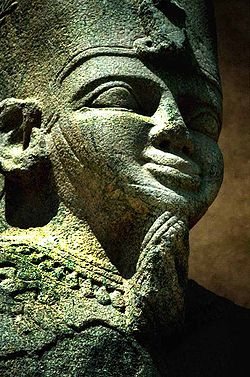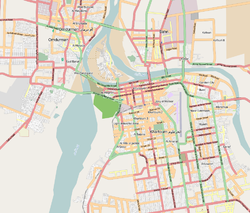- National Museum of Sudan
-
Coordinates: 15°36′22″N 32°30′29″E / 15.606°N 32.508°E
National Museum of Sudan 
A statue of Natakamani in front of the National Museum of SudanEstablished 1971 Location Khartoum,  Sudan
SudanType Archaeological collection of different epochs of Ancient Sudan and Egypt Website National Museum of Sudan The National Museum of Sudan, founded in 1971, is the national museum of Sudan, located on El Neel Avenue in Khartoum. The double storied building was constructed in the 1955, and established as the National Museum of Sudan in 1971. It contains the largest and most important archaeological collection in the country.[1] [2][3]
The museum has exhibits from different epochs of the Sudanese history such as Kingdom of Kush and ancient Nubia, and also ancient Egypt. Among the exhibits displayed in the gardens surrounding the museum are the two Egyptian temples of Buhen Temple and Semna Temple, which were originally built by Hatshepsut and Tuthmosis III but relocated to Khartoum upon the flooding caused by Lake Nasser.[1][3][4][5]
Contents
Geography
The museum is located on the El Neel (Nile) Avenue in Khartoum at the junction of White Nile and the Blue Nile in Al-Mugran area. It is the largest and most visited museum in Sudan.[4][6]
Description
Even though the building was built in 1955, its actual occupation as a museum took place in 1971. It is a double storied building where ancient architectural antiquaries are displayed. The antiquaries displayed relate to the history of the ancient Kush kingdom and the Nubia's Christian period. The artifacts on display are: Stone age relics of the Al Saltan Al-Zarqa era also known as the black sultanate; Kush glassware, pottery and statuary; frescoes and murals of the Nubia’s period from the 8th to 15th century. The frescoes made in water colour are well preserved and appear bright and clear.[1][5]
Apart from the exhibits inside the museum, the garden area around the museum has ruins relocated from the submergence area of the Lake Nasser created by the Nasser Dam on the Nile River. These are ruins of two temples namely, the Buhen and Semna built by Queen Hatshepsut and Pharaoh Thutmose III.[4] The Aswan High Dam built across the Nile River in Egypt created a reservoir in the Nubia area, which extended into Sudan's territory threatening submergence of two ancient temples of 1490 BC period. On an appeal made to the UNESCO to retrieve these temples and shift them to a safer location, the temples and tombs were systematically dismantled from the submergence area and relocated in the garden surrounding the National Museum of Sudan in Khartoum.[1][5]
The exhibits in the museum have been catalogued by fifty leading scholars and published as papers or books. 320 objects have been catalogued listing exhibits unearthed from archaeological excavations and finds by way of stone tools of the Paleolithic period, Pharaonic statues of Pharos and ancient Christian wall frescoes and armour of the early Islamic period. The exhibits are of Sudanese culture of their Kerma Kings, graves of the Christian rulers, from the ostentatious temples of the Egyptian pharaohs and also churches and mosques of subsequent periods.[7]
Inscriptions
The catalogue on Greek and Coptic inscriptions, produced primarily by the Christian culture of Nubia, displayed in the museum, was the scholarly contribution of Dr Adam Latjar from the Warsaw University in respect of Greek inscriptions and Dr Jacques Van der Vliet of the Leiden University in respect of Coptic inscriptions. Their project work was funded by UNESCO, Polish Centre for Archaeology at Cairo and the Netherlands Foundation for the Advancement of Tropical Research (WOTRO). The Christian inscriptions contain Nubian funerary inscriptions in the form of funerary epitaphs. The source of these inscriptions are stated to be from Nubian territory in Sudan extending from Faras in the north to Soba in the south. The texts are inscribed on sandstone, marble or terracotta (36 inscriptions, mostly from Makouria ) plaques of generally rectangular shape.[8]
Renovation
The National Museum of Sudan in Khartoum and the Archaeological Museum of Jebel Barkal were substantially renovated with funds to the extent of US$ 230,000 provided by USA to the pilot project under the UNESCO Programme for the Preservation of Endangered Movable Cultural Properties and Museum Development. The project was implemented over a two year period from October 2003 involving conserving, cataloguing, labeling and presentation of the exhibits, creating digital records of all collections and improving security measures.[3]
References
- ^ a b c d "About Sudan". Sudan US Embassy. http://sudan.usembassy.gov/places_to_visit.html. Retrieved 8 May 2011.
- ^ "Preservation of the Endangered Objects of the National Museum of Sudan and the Archaeological Museum of Jebel Barkal". UNESCO. http://portal.unesco.org/culture/en/ev.php-URL_ID=35310&URL_DO=DO_PRINTPAGE&URL_SECTION=201.html. Retrieved 7 May 2011.
- ^ a b c "Preservation of the Endangered Objects of the National Museum of Sudan and the Archaeological Museum of Jebel Barkal". Unesco.org. http://portal.unesco.org/culture/en/ev.php-URL_ID=35310&URL_DO=DO_PRINTPAGE&URL_SECTION=201.html. Retrieved 9 May 2011.
- ^ a b c "National Museum". Lonely Planet. http://www.lonelyplanet.com/sudan/sights/museum/national-museum. Retrieved 9 May 2011.
- ^ a b c Patricia Levy; Zawiah Abdul Latif (30 August 2007). Sudan. Marshall Cavendish. pp. 101–. ISBN 9780761420835. http://books.google.com/books?id=-5GVJGRbImIC&pg=PA101. Retrieved 8 May 2011.
- ^ "Preservation of the Endangered Objects of the National Museum of Sudan and the Archaeological Museum of Jebel Barkal". UNESCO. http://portal.unesco.org/culture/en/ev.php-URL_ID=35310&URL_DO=DO_PRINTPAGE&URL_SECTION=201.html. Retrieved 7 May 2011.
- ^ Derek A. Welsby; Julie R. Anderson (2004). Sudan: ancient treasures : an exhibition of recent discoveries from the Sudan national museum. British Museum Press. ISBN 9780714119601. http://books.google.com/books?id=Q2xyAAAAMAAJ. Retrieved 8 May 2011.
- ^ Adam Łajtar; Sudan. Hayʼah al-Qawmīyah lil-Āthār wa-al-Matāḥif (2003). Catalogue of the Greek inscriptions in the Sudan National Museum at Khartoum (I. Khartoum Greek). Peeters Publishers. ISBN 9789042912526. http://books.google.com/books?id=Ns8wzoRTa9UC. Retrieved 8 May 2011.
Categories:- Buildings and structures in Khartoum
- Museums in Sudan
- National museums
- Museums established in 1971
- Buildings and structures completed in 1955
Wikimedia Foundation. 2010.


